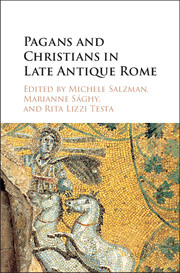 Pagans and Christians in Late Antique Rome
Pagans and Christians in Late Antique Rome Published online by Cambridge University Press: 05 November 2015
The conference on which this volume is based is a significant contribution – albeit not the last in the view of the editors – to the debate on relations between Christians and pagans, which subject has been recently revived in a series of publications. In 2007, the conflict between pagans and Christians in the fourth century was one of the issues on which the organizers of the International Congress, promoted by the Associazione di Studi Tardoantichi in Naples, invited scholars to make a critical assessment. The following year, in the Monastery of Bose, on the pre-Alps around Biella, where the dialog between religions in the contemporary world is a subject of daily engagement, a new international conference (supported by the Fondazione per le Scienze Religiose Giovanni XXIII in Bologna) gathered scholars of at least three different generations, and from various nations of the world, to discuss this topic. Favoring a historiographical approach, the scholars at this conference traced the directions of historical research since the publication in Oxford in 1963 (and in Turin in 1968) of Arnaldo Momigliano's The Conflict between Paganism and Christianity in the Fourth Century. That book has had an almost paradoxical destiny. As Peter Brown noted as a young listener of the Warburg Lectures and as the first reviewer of the volume's English edition, almost all of its collected essays showed how the Christianization of the empire passed through a process of transformation and transition, rather than competition, struggle, or conflict. In one essay, however, the idea of conflict stood out in a specific way and it was from that essay – which had been conceived more than a decade before – that Momigliano drew inspiration for the title of the volume. He found in Bloch's chapter, which he included as the epilogue to this miscellaneous work, a satisfactory answer to his own view that religious factors were an inseparable part of historical processes, and hence they played a decisive role in the fall of the western empire. Bloch's response was also consistent with the interpretation of the end of Roman paganism that Alföldi had advanced in his interpretation of the contorniates – bronze medallions, produced in Rome from the mid-fourth to the late fifth century, and whose legends were mostly inspired by traditional gods and heroes – as part of a concerted campaign of pagan propaganda sponsored by the aristocracy of Rome.
To save this book to your Kindle, first ensure [email protected] is added to your Approved Personal Document E-mail List under your Personal Document Settings on the Manage Your Content and Devices page of your Amazon account. Then enter the ‘name’ part of your Kindle email address below. Find out more about saving to your Kindle.
Note you can select to save to either the @free.kindle.com or @kindle.com variations. ‘@free.kindle.com’ emails are free but can only be saved to your device when it is connected to wi-fi. ‘@kindle.com’ emails can be delivered even when you are not connected to wi-fi, but note that service fees apply.
Find out more about the Kindle Personal Document Service.
To save content items to your account, please confirm that you agree to abide by our usage policies. If this is the first time you use this feature, you will be asked to authorise Cambridge Core to connect with your account. Find out more about saving content to Dropbox.
To save content items to your account, please confirm that you agree to abide by our usage policies. If this is the first time you use this feature, you will be asked to authorise Cambridge Core to connect with your account. Find out more about saving content to Google Drive.